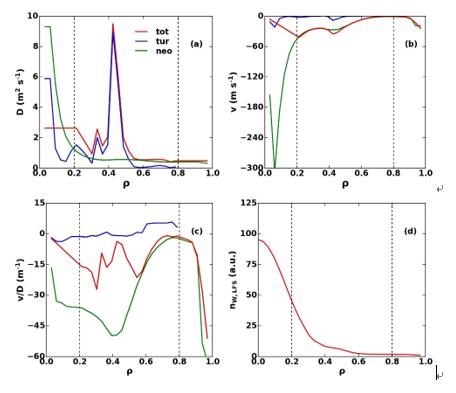
With good properties, heavy/high-Z metal material has been considered as the first choice for plasma facing components in International Thermonuclear Experimental Reactor (ITER). However, at thermonuclear fusion relevant temperatures, the accumulation of heavy/high-Z particles in the core region may significantly cool the plasmas, deteriorating the plasma performance and leading to H to L-mode back transition and even further to radiative collapse. Therefore, it is important to know more about the core heavy impurities transport so as to control their central accumulation for the stable operation of Tokamak fusion devices.
A research team from Institute of Plasma Physics (ASIPP), Hefei Institutes of Physical Science (HFIPS), Chinese Academy of Sciences (CAS) studied the core heavy impurities transport in the hybrid and fully non-inductive scenarios on Experimental Advanced Superconducting Tokamak (EAST). They identified the dominant mechanism for the core heavy impurities accumulation and control.
Scientists found that the toroidal rotation and density peaking of the bulk plasma are usually large in the central region, which is particularly prone to the heavy impurity accumulation. With the advanced integrated modeling, they reproduced these experimental observations, and identified that the large inward neoclassical pinch/convection velocity of heavy impurity produced by large toroidal rotation and density of the bulk plasma, is the one of the main reasons for the accumulation.
Aside from that, they found that increasing the electron temperature and its gradient by electron cyclotron resonance heating (ECRH) could enlarge the linear growth rate of trapped electron mode (TEM) so that the turbulent transport especially the turbulent diffusion is large enough to offset the unfavorable neoclassical pinch of heavy impurity to avoid the heavy impurity accumulation. The comparison of measured spectroscopic data in EAST with computations in an integrated modeling workflow has also been performed.
A series of related achievements have been published in Nuclear Fusion.
This work contains meaningful results presented in a clear and comprehensive way that should greatly interest the fusion community. The results of description and discussion form a quite comprehensive overview of study of core heavy impurity in Tokamaks.

Figure 1. Radial profiles of (a) diffusion coefficient, (b) pinch velocity, (c) the ratio of pinch velocity to diffusion coefficient, (d) tungsten (W) density of 0 flux in the low field side (LFS) in a hybrid discharge (shot #71326) on EAST. (Image by SHI Shengyu)

Figure 2. Profile of (a) diffusion coefficient, (b) pinch velocity, (c) the ratio of total pinch velocity to total diffusion coefficient of tungsten (W) with/o ECRH (EC) on EAST. (Image by SHI Shengyu)